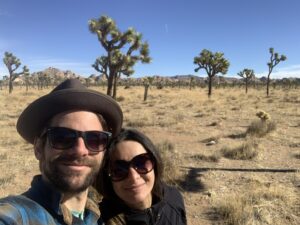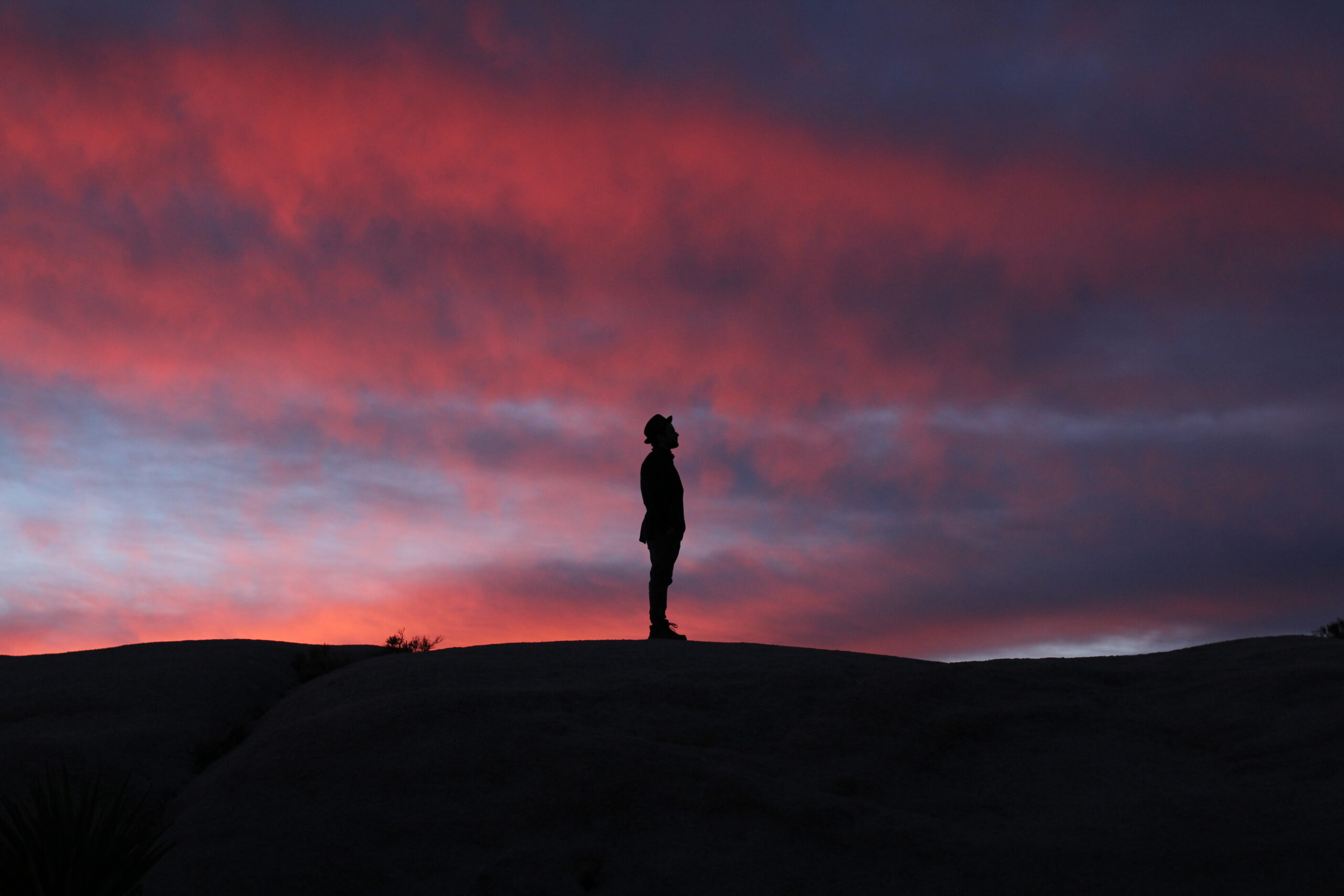Written by Travis Knight // Photography by Camila Pereira
Far down in the southwest corner of California, surrounded by high desert, is a place best described as prehistoric. The arid region sits in stillness, wide and magical to the eyes, a scene lapsed by timelessness. The medley of different boulders and rocks rise and fall in between bouts of flat desert, riddled with shrubs and hidden communities of critters in between, each of their lives depending on the seemingly unlivable landscape.
Over the years, friends who have fared to this intriguing, yet relentless, place have described it as stepping into an episode of The Flintstones. Even Jane Rodgers, a Vegetation Specialist who works and lives in the area described it as a place “straight out of a Dr. Seuss book.” Amidst the mute miles of calm desert, a key player makes this region especially unique. It reaches up, its prickly fingers outstretched and grabbing for the bold blueness of the sky above. These characters can be found in other desert regions, but not nearly as abundant as this place. It is here where thick groves, almost unbelievable when met face-to-face, inhabit miles and miles of unforgiving flatness. It is here where the Joshua tree thrives far and wide.
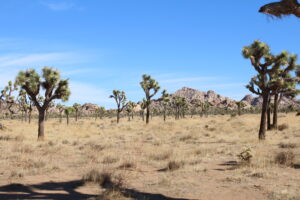
Day 1: Pappy & Harriet’s Pioneer Palace
It was New Year’s Day, 2021 when we awoke in a stale hotel room. As the late morning sun exerted its way through the slits between blinds, the room heated up, furthering the smell of stagnant filth. Milla and I quickly packed our bags, checked out of the hotel, and started searching for coffee in the small town of Buttonwillow. The town is a common stop for weary LA-bound travelers who don’t want to face the night-cloaked Grapevine. It is also a common stop for people who are traveling east, to Bakersfield and beyond. For hotels, it’s a good place to save a buck.
A few weeks prior to New Year’s 2021, we had decided to get out of town and do something special to celebrate the departure from the shitshow year of 2020. Both of us had some time off of work for the Christmas break, so we figured we could explore somewhere that was usually too far to venture on a traditional weekend. After some brief brainstorming and research, we decided that we would go backpacking in Joshua Tree National Park.
“… to celebrate the departure from the shitshow year of 2020.”
As always, Milla and I had gotten to a late start that day. We barely made our check out at noon. Then we wanted coffee, so we went and grabbed coffee. Then we were hungry, so we had to find a halfway decent place to eat. By the time we finished our late breakfast and got gas, it was after 2 p.m. Once officially fueled by coffee, food, and gas, we left Buttonwillow behind us, driving Interstate 5 south until it met California 58; Bakersfield bound.
Once we passed Bakersfield, we continued on Highway 58, east and then slightly southeast to Tehachapi, a town that welcomes travelers to the Mojave Desert. In Barstow, we would jump on the California 247, a scenic two-lane road that takes drivers through a long open landscape of rolling desert, basking travelers in beauty every mile of the way. We drove south until we hit Lucerne Valley, famously known for its dairy products. Once there, we stopped on the side of the road, popped open a small bottle of champagne, and made a toast to the setting sun. Then, back on the road.
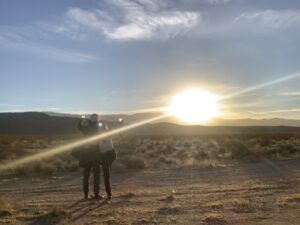
We continued on the 247 as it weaved through desert scenery, dancing in the late golden hour’s light. We drove east and then slightly south until we met Yucca Valley. By the time we pulled into Yucca Valley, the sun had bid farewell, so we knew that Joshua Tree National Park would have to wait until the next day. Now no longer racing against time, we decided to take a pit stop for dinner. From Yucca Valley, we slightly backtracked northwest to a historical culinary staple of southern California: Pioneertown’s iconic Pappy and Harriet’s Pioneer Palace.
My introduction to Pappy and Harriet’s was from a song by the famed country singer/songwriter, Jim Lauderdale. His “I Met Jesus in a Bar” was filmed at Pappy and Harriet’s, offering an old-western look to host the spirit of the song. Ever since my father shared that music video with me, Pappy and Harriet’s restaurant, bar, and venue made its way onto my bucket list. However, the story of Pappy and Harriet’s digs much deeper than an Americana music video.
Back in 1946, the building that is today Pappy and Harriet’s Pioneer Palace was used as a movie set, a Wild West cantina for old Western films. Once the building retired its career as a movie set, Harriet’s parents bought the building, salvaged the exterior, and transformed the inside into an “outlaw biker burrito bar.” In those days, Pappy and Harriet’s was known as “The Cantina.” The restaurant/bar thrived for a decade until Harriet’s parents closed up shop in the early 80s. Nevertheless, the space wouldn’t be closed for long. In 1982, Harriet and her husband Claude “Pappy” Allen took advantage of the lingering biker gangs who still frequented the area, turning the space into what it is still known as today.
Tragedy struck Allen and Harriet in 1994 when Pappy passed on. Shortly after his death, Harriet sold the place to a buyer who was close to the family. Just some years later, though, this family friend would end up shutting down the establishment once again. Not long after that, a group of patrons who loved Pappy and Harriet’s Pioneer Palace bought the place and kept its legacy alive as a haven for good food, a cold drink to wash away the desert, and live music.
“Pappy and Harriet’s Pioneer Palace… a haven for good food, a cold drink to wash away the desert, and live music.”
However, due to COVID restrictions, we could only venture far enough inside the historic establishment to use the bathroom. Food was only available in to-go containers, so we did not get to really experience the place. Somehow, 2020 was still managing to rear its ugly head into the new year of 2021. And even though we were in the middle of the desert, COVID-19’s restrictions proved no bounds.
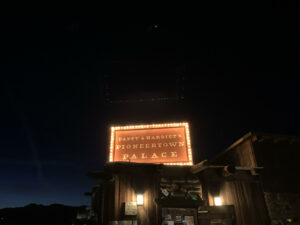
Milla and I scarfed down our to-go burgers with fries and got back on the road. Our next stop would be the cheapest hotel we could find either in the town of Joshua Tree, or close by. We ended up finding a cheap hotel in Twenty-Nine Palms, the town right next to Joshua Tree. Around 10 p.m. that night, we checked in to our hotel, loaded up our bags, took showers, and slid into bed. My traditional habit when staying in any hotel is to find the truTV station, plop into bed next to a sleeping Milla, and fall asleep to the ominous voice of Peter Thomas. This stay was no different.
Day 2: Joshua Tree National Park
Milla and I got off to an early start the next morning (for once!), making quick work of checking out. We grabbed a quick bite to eat and headed straight for the park. Once in the national park, the abundance of Joshua trees was overwhelming. The strange trees were everywhere, speckled throughout the landscape as far as the eye could see in every direction. Immediately, my mind started to wander. I could not help but wonder about the history of humans’ relationship to this enchanting region. And why were these bizarre plants named Joshua trees?
In the early days of Joshua Tree National Park, long before the arrival of Europeans, tribes such as “the Serrano [and] the Cahuilla” lived in the area. History suggests that the Serrano were eventually pushed out by the Chemehuevi tribe, while the Cahuilla tribe held their ground in “the southern part of the park.” By analyzing artifacts left behind and songs that lived on through tradition, archeologists believe that the Mojave tribe also frequented the area in a seasonal manner, using the region as a haven when traveling to the coast for trade purposes.
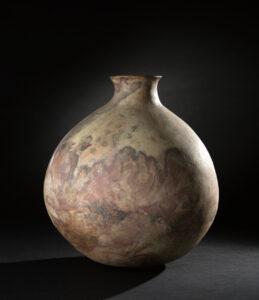
Before the name Joshua tree was dubbed, the Cahuilla called these large relatives of the Agave plant “hunuvat chiy’a or humwichawa.” When the European settlers arrived—specifically Mormons and miners—they attributed the trees’ characteristics to the biblical figure, Joshua. Although the exact reason why these settlers anthropomorphized the spindly limbs of these pants to the bible’s Joshua is not concrete, it is certain that biblical reference was the reasoning behind the title.
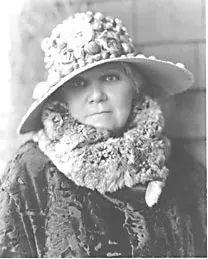
The story of how this region became a national park started with a desert plant enthusiast from Pasadena, Minerva Hoyt. The 1920s brought “an influx of land developers and cactus poachers” to the desert, causing grave concern from Hoyt. She knew that this region’s ecology was at stake, and by constantly fighting for its protection, she accomplished her mission in 1936 when “825,000 acres” had become the protected Joshua Tree National Monument. However, it would not be until the end of October 1994 that the Desert Protection Bill would append “234,000 acres” as federally protected land, marking the moment when Joshua Tree National Monument became a national park. Today, Joshua Tree National Park is home to “813 higher plant species, 46 reptile species, 57 mammal species, and over 250 bird species.” Nevertheless, even amidst protection efforts, several species of plants, “the desert tortoise, [and] the triple-ribbed milk vetch” still face endangerment. This is a grave reminder that even the most hardy environments have fragile ecosystems.
Natural Playgrounds & A Giant Skull Rock
It didn’t take long after Milla and I entered the park through the North Entrance Station that our eyes were brimming with enchantment. Aside from the miles of Joshua tree groves that spread out in every direction, we were intrigued by the huge boulders. A gathering of cars bordered a gargantuan gathering of these large rocks, so we stopped to check it out. Immediately, we were immersed in a playground carved out by nature, with huge rocks perfect for climbing. We quickly peaked the tallest of these boulders, sat in awe as the desert spread out before our eyes, and then made our way back to our car.

The next stop was Skull Rock, the title of the location providing a self-explanatory description of the thing. After battling for a parking space, Milla and I made the short trek to Skull Rock. This giant granite structure surely lived up to its name, a huge bulbous rock with a bowl-like feature carved out, signifying the eye of the skull. It was a cool sight, but it was crawling with spectators. A large line weaved towards Skull Rock, full of eager site-seers waiting their turn to capture a photo of themselves standing in front of it. It felt as if we were at a theme park, waiting to get on the most popular ride. Milla and I skipped the line, stood in front of Skull Rock as it teemed with people like fleas on a pebble, visually breathed in its aesthetics, and left. We didn’t even take a picture.
Looney Tunes
Once back in the car, we prepared our next move. We wanted to find a place where we could park and walk out into the desert to camp. Not far from Skull Rock was the Twin Tanks area. On our way to our destination, we experienced our first wildlife sighting, a scraggly little coyote that bolted across the two-lane road. I shouted out in excitement as I slammed the brakes to catch another glimpse of the desert creature. With the back of his triangular pointed ears and his fluffy tail staring us down, he continued his elegant stride into the desert. To our advantage, he stopped and turned his small head back toward us. His tongue was out as he panted away the grueling sun above. Then, as quickly as he had appeared, he disappeared into a sea of desert shrubs and Joshua trees.
It was not much further to Twin Tanks. Just driving through Joshua Tree is magic in itself, so it isn’t surprising that the concept of time seemed to melt away in such a scene. From entering the park to Skull Rock, to the coyote sighting, and then to Twin Tanks; time seemed dormant–it felt like not a minute passed us by. Before we knew it, we were unloading our gear in the parking lot of the Twin Tanks trailhead. There we would have our second wildlife encounter.
“… time seemed dormant–it felt like not a minute passed us by.”
As I packed my gear, a curious little bird ran right up to my right foot and looked up at me. It was a strange little bird, with a pointed beak and white splotches on its head, upper body, and dark-colored wing. His feet were short, but his tail feather was long, possibly a bit longer than the bird itself. As I finished packing my gear, I accidentally shuffled my foot too close to the peculiar creature, causing him to run away. When it ran, its long tail and beak became horizontal, and for such a small creature, the tiny dude could run. After eyeing me from a distance away, it waited and… zoom! It bolted back, again with its beak and tail in perfect horizontal harmony. Just inches from my feet, it cocked its eye up at me, silently begging me for a crumb. This time, Milla walked around the car and unknowingly scared it off. And again… zoom! The tiny bird was off again. It reminded me of something I knew, but I just couldn’t put my finger on it. The way it ran, horizontal and super-fast… I knew I had seen that somewhere.
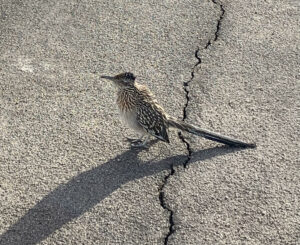
This would be the first time Milla or I had ever done a hike into the desert, let alone backpacking. So, we thought it wise to keep it pretty close and pack light. Therefore, we packed my backpack to the brim, with tons of water, our cooking gear, some food, a few books, and our trooper of a tent: a four-person (not ideal but all we had) Coleman tent that we dubbed Big Green. The desert sun was blaring, so I carried the backpack and Milla hauled her smaller pack full of her camera gear.
As we approached the trailhead, the curious little bird followed us all the way, begging for a bite to eat. Every time it ran, I could not help but feel a deep sense of nostalgia. At the trailhead, the bird lagged behind and took off to try its luck with another set of hikers in the parking lot. A ranger greeted us, and I had to ask him: what kind of bird is that? His reply fulfilled all of my suspicions. Yes, it was a road runner!
So, our first two encounters with wildlife in Joshua Tree National Park were that of a coyote and a road runner. Thus far, I have heard people describe Joshua Tree as a scene from The Flintstones or a Dr. Seuss book. But no one had ever mentioned Looney Tunes!
We didn’t need to walk far to get out into the ruralness of the desert. Our hike was only a mile or so down the Twin Tanks trail and then about another mile off the trail. Far off behind us, the parking lot sat shrunken, the cars in it now looking like glimmering ants. Behind a large granite boulder, we found our temporary home, where the flatness was ideal, the large stone offered privacy, and an already constructed fire pit awaited.
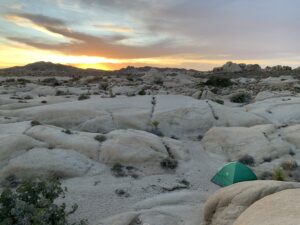
Milla and I quickly set up camp and then decided to lay out a picnic blanket on the huge stone above our camp. As we sat up there with eyes in our eBooks, a brisk breeze crept through the desert, swiftly cooling off the hot day that had been. Time, as it seems to do out in the desert, slipped by without us realizing it.
After my literary appetite was satisfied, I started gathering firewood, which was mostly the skeletons of dried-up and deceased desert shrubs. By the time I finished gathering fuel for the fire, golden hour had befallen, and what we were about to witness was by far one of the most beautiful sights that either of us had ever laid eyes on.
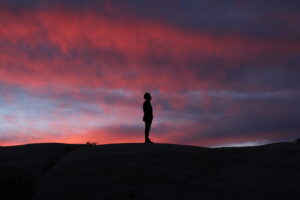
The sky had erupted into a dazzling display of color. Horizontal rows of clouds soaked in the setting sun, reflecting a fiery pink on their fluffy skin. Between the clouds, a soft blue and light purple peaked out from in between their rows. The vast desert sky, roaming far and wide, is just unbelievable at sunset. The spectacle lasted as long as a sunset does, and as darkness washed in over our heads, the temperature began to violently drop. We decided it was time to hit the tent and cuddle up to cope with the cold creeping in.
I awoke in the middle of the night to a nagging bladder. As I sat up, Milla awoke, complaining that she had not been able to sleep due to the cold. At that moment, I realized just how cold it was. The desert’s scolding day had significantly shifted, from high 80s to mid 30s. I remembered that I had gathered a bunch of dried-up desert brush and other flammable items earlier that day. So, we decided to brave it out of our tent to try and warm up next to a much-needed fire.
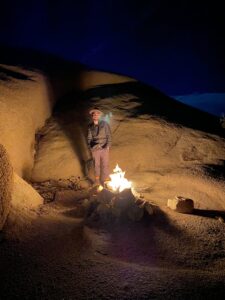
The dry desert brush exploded into flame almost instantly. However, like most fuel that burns big and bright, the flame was short-lived. Nonetheless, Milla and I were able to enjoy at least thirty minutes of warmth. Above, the great Milky Way Galaxy churned above our heads. After a quick snack and as the fire’s flame bid its final farewell, we crawled back into our tent and fell asleep.
Unfortunately, the next day started in a rush. Neither of us had slept very well due to the brittle cold the night before. So, we awoke later than we had wanted. Now that daylight sprawled across the landscape, we could see ant-like flickers cruising along the pencil-line road, the now blaring sun bouncing off the faraway cars. After a quick breakfast, we packed up camp and walked straight through the fields of cactus and Joshua Trees. Although shrunken by distance, we could see the parking lot. So, instead of finding the trail, we just walked straight in the direction of our car. Both of us needed to be back at work early the next morning, and we were still 7 hours or so from home.
Pioneertown: One Last Stop
On our way into Joshua Tree, Milla and I made a quick dinner stop in Pioneertown. The town is known for its old western aesthetics but since Milla and I rolled in after dark, we were not able to experience the place for what it was. So, on our way back home, we decided we would make one last stop.
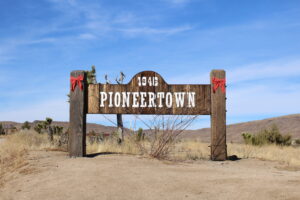
After sliding by Pappy Harriet’s for a cold drink, Milla and I started our tour through Pioneertown. With our refreshing cocktails in our hands, perspiring in their plastic to-go cups, Milla and I could finally see Pioneertown in its purest potential. The day was beautiful, with vast blue skies and a soft breeze that would come and go. The town looked like a giant movie set, and that’s because it is. Well, that’s what it was.
Back in the 1940s, Dick Curtis, an old Western actor, came up with an idea to make filming Western films—a genre particularly popular during that time—more affordable. His idea was to build a permanent movie set, with some of the buildings actually functioning as small-town staples such as grocery stores, a cantina, and horse stables. Hollywood loved the idea, and with a group of investors, Curtis’s vision solidified into what still stands today: Pioneertown.
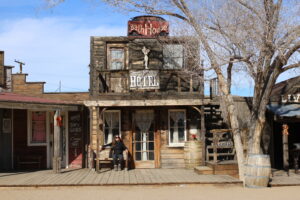
Today, Pioneertown still stands. However, instead of it being a movie set, the old Western-style town is actually a town. Most of the movie-set buildings have been turned into shops or other tourist attractions, and of course, the iconic Pappy and Harriet’s Pioneer Palace is still operating. As our cocktails lowered in our cups, becoming more ice-melt than booze, Milla and I strolled down the one-street town, taking pictures and enjoying the archaic architecture. As the late afternoon befell upon us, we knew it was time to get back on the road for a long drive home. Behind us, we left the Joshua trees and the old-western feel of Southern California’s desert region. Behind us was quite possibly the most tumultuous year experienced in our lifetime. Ahead of us was a long drive, a new year, and newfound adventures awaiting in the nearby future.
